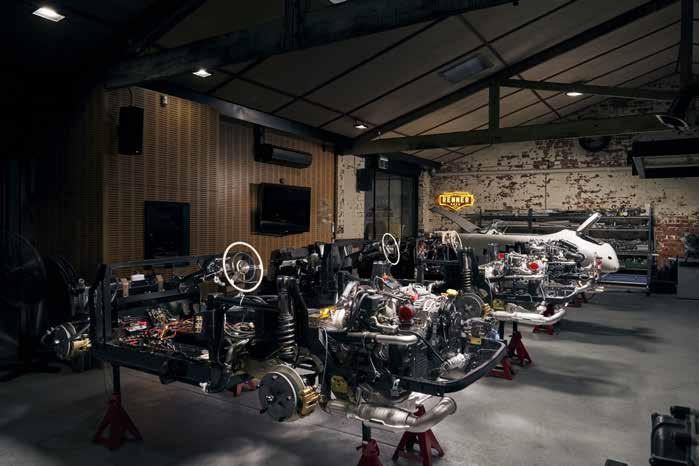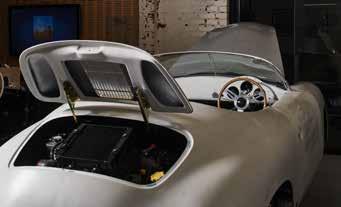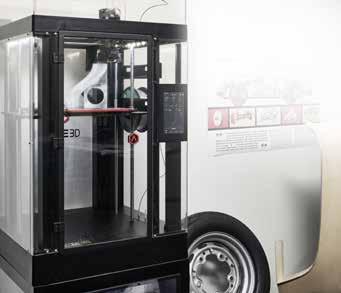
7 minute read
COMPANY FOCUS
from AMT DEC/JAN 2021
by AMTIL
Renner Auto – Modernising classic vehicles with advanced manufacturing After 30 years working in the global automotive supply industry, from R&D to senior management, Renner Auto’s owner and founder Jason Ferraro is now following his passion – building and restoring classic vehicles with innovative high-tech chassis and drivetrain systems. By Carole Goldsmith.
Excitement was at an all-time peak at Renner Auto this October, when the first of four Renner Auto Speedsters rolled out for inspection and testing. These updated classic vehicles are being built using the latest in advanced manufacturing at the company’s workshop in Melbourne’s eastern suburbs. Proudly standing beside these four Speedsters – open with chassis, engine and internal components on display – Ferraro says that the first two Speedsters will be ready before Christmas, with the other two completed early next year. Nearby, team member and fellow engineer Kevin Reich performs general assembly work on another of the Speedsters. The vehicles are all replicas of the classic 1956 Porsche 356A Speedster, but with modern high-tech mechanical and electronic systems. Ferraro points to the PWR radiator and turbo charger intercoolers in each of the four cars and advises: “PWR is a tremendous partner in our Speedster recreations and one of the many excellent local suppliers we use.” Ferraro uses a wall display of 3D-printed Speedster models for clients to choose the vehicle’s external colour and upholstery. “We commenced the Speedster development project one and a half years ago and all of these vehicles are pre-sold to clients,” he says. “Components for the next four Speedsters are being procured now and we plan to produce up to eight of them each year. “Although we modelled and designed the vehicles to closely resemble the original item, we sell it as a Renner Auto Speedster. You can’t recreate a vehicle from scratch and call it a Porsche, and it can’t leave our workshop with Porsche badges on it. We can however restore a Porsche from scratch and it can retain the Porsche badging, as a restored vehicle. “An original classic Porsche Speedster can sell for more than $700,000. Currently, we have an original Porsche 356 Coupe in the workshop, which we are completely modernising internally, so it can keep its Porsche badges on it.” Ferraro speaks with great enthusiasm for his business: “Renner Auto is celebrating the high point of automotive design, the period
Renner Auto builds its vehicles in small batches to realise economies of scale.
between 1950 and 1970, through the building of new cars, that pays tribute to that period’s styling. These vehicles possess the styling that make them an instantly recognisable classic. By using advanced manufacturing, we build a modern chassis, engine and electrical system that makes them as advanced in technology and up to date as new vehicles.” He shows an AC control unit for the Speedster that he had just printed on the Raise 3D Pro2 Plus machine: “I purchased the 3D printer two years ago for around $11,000. We 3D print prototype and select production parts using this equipment, and it has enabled us to implement OEM (original equipment manufacturer) solutions at volumes that were not previously viable. As well as the 3D printing and supporting CAD design work, I do a lot of general workshop operations, such as TIG/MIG welding and composite work.” Dream machines How it works at Renner: most clients are local and after scheduling an appointment, they’ll come into the workshop for a site visit. Ferraro says that some clients have even ordered their vehicle build on the spot. Several of Renner’s custom vehicle projects have seen clients investing over one million dollars to create their dream vehicle. “I provide an estimated price and time frame to the client, and we often run on an open book costing model,”says Ferraro. “We use 3D scanning equipment to digitise the vehicle structure and then commence the 3D CAD design of all the vehicle systems. Then we install the modern internal components in the body, so that it resembles the original vehicle with a high-tech engine and a modern internal operating system. The recreation of a classic vehicle takes between 1,000 to 2,500 hours to build and there are usually up to six cars being built at a time. Significant time is spent on vehicle R&D and fit-out. “Clients are involved during the build both via Zoom, regular newsletters and now face to face, post COVID-19 lockdown. They get very excited, like we do, when their custom-built vehicle is nearing completion.”
In-house 3D-printed components are used for prototype and final production components, using a Raise 3D Pro2 Plus supplied by Bilby3D.

A fully digital design process has enabled Renner Auto to package a complex vehicle system within an authentic Speedster body shape.

Driven by passion Before founding Renner Auto, Ferraro had worked in senior management roles at several large global corporate automotive supply companies, including Air International Thermal Systems, Futuris Automotive and TE Connectivity. After 30 years, he decided it was time to move on and take on new challenges, doing exactly what he enjoys. “I was nearing 50 and had enough behind me to start my own business,” he recalls. “So, I launched Renner Auto, enabling me to follow my passion, working with advanced manufacturing and technology, applying a unique skill set in the construction of custom cars from the 1950s to the late 1970s.” While the Renner team specialises in producing the Renner Speedster as an important sideline, its main business is to custombuild classic cars of this same era. The iconic Ford GT40 and Jaguar XJ13 replicas are two builds that Ferraro is very proud of. The skyblue coloured GT40 replica had been his hobby project for after work and weekends until he started Renner Auto. It’s also one of his favourite creations to date, which he proudly built over seven years. “That’s my own car, so it’s not built for clients,” he says. “And my 12-year-old daughter has already claimed it for when she is old enough to drive. We also have a four-year-old daughter, whom I will probably build an electric Speedster for when she’s older.” Ferraro writes a comprehensive blog on his website and describes the build and modifications of some of Renner’s classic custom car replicas. The Jaguar XJI3 build’s progress are among these blog reports. The Jaguar XJ13 replica includes a V12 engine and the same transaxle as used in a Lamborghini Gallardo. Ferraro advises that only one XJ13 was ever built and the dashboard layout was not that functional. “The client was happy for us to create a dashboard that had as many original details as possible,” he says. “However he wanted the speedometer and tachometer behind the steering wheel.” During the Melbourne COVID-19 lockdown, Ferraro had two of his four-person Renner team assisting him on the job: “I also engage RMIT undergraduate mechanical engineers to spend time in the workshop, as we have a great mix of theoretical and hands-on engineering tasks, on a daily basis. We plan to employ extra full-time staff as we are getting very busy in the workshop.” Ferraro adds that the Federal Government’s JobKeeper grant has assisted the business weather the COVID-19 crisis, while the R&D Tax Incentive program has helped to support an innovative automotive project. “If you are undertaking true R&D activities there is some great support out there from government.” Data driven Ferraro graduated with a degree in mechanical engineering from RMIT University in the early 1990s. “As an engineer, you become a data driven person,” he remarks. “The engineering degree made me the person I am today; however, I was also very fortunate to start my career as a graduate engineer at Air International Thermal Systems. “I started work in the R&D area and moved to managing and running the climatic tunnel. I had access to the machine and pattern shop, and had the good fortune to learn from people with years of skill in these disciplines. This provided invaluable experience and skill development that I use today, and can pass on knowledge to apprentices and contracted employees. In recent corporate roles, I learnt a lot about innovation and advanced manufacturing, such as 3D printing and CAD systems, which we now use extensively.” Ferraro’s plan for Renner is to build vehicles equipped with electric drivetrains within the next two years. He explains that the electric drivetrain is a far more elegant and efficient system, with far fewer components than a combustion engine. “We will employ an engineering graduate who is interested and trained in that technology and start developing the electric drivetrainpowered classic vehicle. We are also looking at the maturity of the technology in the automotive aftermarket. There are already companies that can supply businesses like mine, restoring classic cars with electric ,drivetrains and I look forward to working with them in the near future. “Over the years I have learnt what motivates me,” Ferraro adds. “At the top of this list is to be working in a company where innovation and technology are core to the business success. Working with new technologies is my passion and at the centre of everything I do, at a professional and personal level.”
www.rennerauto.com.au











